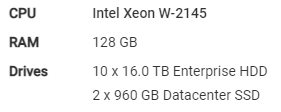Hi all! I'm afraid I don't know how to ask the right question, so sorry if I'm being unprofessional.
I have a dedicated server on Hetzner. I installed TrueNAS SCALE on it and it works fine. Now I want to increase the amount of storage, but I can no longer install more physical disks on the server. If I understand correctly, there are so-called network storages that, via iSCSI or something like that, give access to block devices over the network. So I need to rent another server, make network storage out of it and somehow connect its disks to the first TrueNAS server? Or are there other solutions?
By the way, I see that TrueNAS can act as an iSCSI Target. But I don't see anywhere that it could be an iSCSI Initiator. Is this even possible without interfering with the OS?
I have a dedicated server on Hetzner. I installed TrueNAS SCALE on it and it works fine. Now I want to increase the amount of storage, but I can no longer install more physical disks on the server. If I understand correctly, there are so-called network storages that, via iSCSI or something like that, give access to block devices over the network. So I need to rent another server, make network storage out of it and somehow connect its disks to the first TrueNAS server? Or are there other solutions?
By the way, I see that TrueNAS can act as an iSCSI Target. But I don't see anywhere that it could be an iSCSI Initiator. Is this even possible without interfering with the OS?

![geek_male_man_emoticon_emoji_sticker_computer-512[1].png geek_male_man_emoticon_emoji_sticker_computer-512[1].png](https://www.truenas.com/community/data/attachments/65/65548-8b50377b5769a5d4476b5973c8800aa0.jpg)

